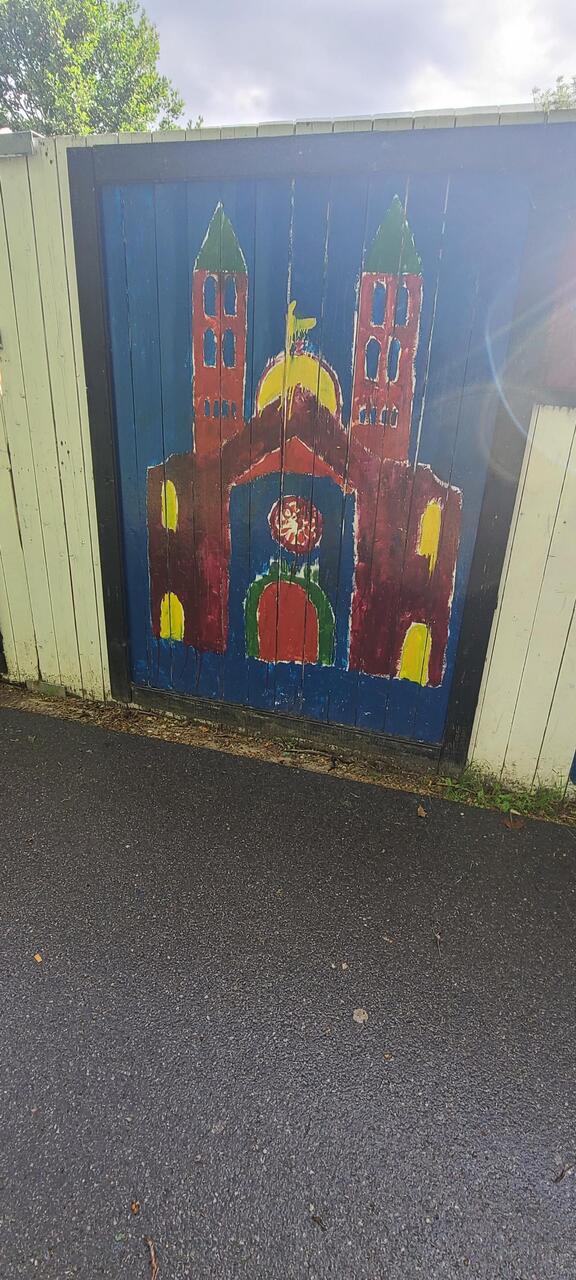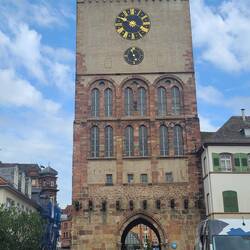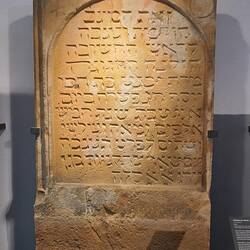- Show trip
- Add to bucket listRemove from bucket list
- Share
- May 29, 2022, 10:47pm
- 🌙 10 °C
- Altitude: 71 m
 GermanyHesseRudesheimKemptenRüdesheimer Aue49°58’36” N 7°56’14” E
GermanyHesseRudesheimKemptenRüdesheimer Aue49°58’36” N 7°56’14” E
Fünf Fotos-Rhine Cruise Day 4
 May 29, 2022 in Germany ⋅ 🌙 10 °C
May 29, 2022 in Germany ⋅ 🌙 10 °C
We had a restful night moored about a mile from Speyer's old town. Although a group tour was arranged, we decided to repeat our independent journey into town based on the presentation we had heard about the highlights of Speyer. Admittedly, while we had heard of Speyer previously, we knew very little about the town.
When we left the boat, it was a bit chilly and was threatening to rain. The first thing we noticed on the way to town was a series of children's paintings on a wall outside a restaurant. It captured for me the innocence of children, and my thoughts returned to those who were murdered earlier in this week as well as those who witnessed it. May we have the resolve to do better for them.
We loved the forested walk to the center of the city. The green space was lush and it it was a quiet morning. It really felt like we had the city to ourselves.
I took the time to go into the Domkirche St. Maria und St. Stephan (Speyer Cathedral) about 45 minutes before church services while Jim C explored the adjacent courtyard. There were only a handful of people in the cathedral, and I appreciated the stillness.
In contrast to many of the Italian Cathedrals, this one is beautiful in its stark simplicity. The stained glass windows are shades of grey Purportedly, construction began in 1024 A.D. In reviewing the history there were several reconstructions after fires, reconstructions and battles. The different architectural approaches are quite evident when viewing the exterior of the church. While the crypt was closed, there were several inscriptions on the floor near the altar memorializing a number of emperors, expresses and bishoos who were laid to rest.
As we left the church grounds, we walked toward the St. George Fountain in the center of the old town. As we used a tool to translate the various inscriptions surrounding the image of St. George, it became more clear that this fountain was created as part of 1930's Nazi propaganda in honor of fallen soldiers in WWI. Upon further research, I learned that subsequently the Speyer Town Council added a plaque noting that this captured the sentiment of the time, a seemingly week rationalization for the portrayal. I don't think it's unlike too many politicians today wanting to gloss over our own country's history of white supremacy.
Shortly before we reached the old town gate (Altpoertel) a cacophony of bells sounded which seemed intent on waking the entire city. They continued for about fifteen minutes.
The Altpoertel is the medieval west city gate of Speyer. and is one of the original 68 towers in the old walls and gates. It was originally
constructed in the 13th century with several reconstructions over the centuries. It was almost destroyed by French troops who relented when monks pleaded to spare the tower for fear that it would fall and destroy the monastery. It survived; the rest of Speyer and the cathedral were destroyed. It stands today as one of the largest city gates in Germany.
As we left the Altpoertel, we devoted most of our time in Speyer to visit the ShUM Speyer, a museum dedicated to the Jewish heritage in Speyer dating back over 1000 years ago.
In 1084, a Bishop took in Jewish refugees from Mainz. Jewish and Christian communities coexisted in peace for over four hundred years. The persecutions around the Black Death ended that time of peace. Subsequent attempts to reestablish the Jewish community were disrupted frequently in the 1500's. The destruction of Speyer in 1689 also witnessed the destruction of the synagogue.
We toured the remaining structure of the synagogue and adjacent women's school. Women were allowed to listen to what was happening in the synagogue through acoustic slits in the wall.
We toured the Mikvah ("kiving water"), the ritual bath used for cleansing. It was remarkably intact and it still collects rainwater as it did when constructed.
We toured the museum on the grounds of the old Jewish Cemetery that no longer exists. The medieval buildings on Kleine Pfaffengasse (Old Jewish Lane) were destroyed by the great fire in 1689.
After the Jewish community in Speyer was destroyed, the cemetery headstones were used as building materials. The markers of those who had passed now became part of walls, bridges and private homes.
Today abut 50 of the headstones have resurfaced, and they richly describe in Hebrew the lives of those who passed.
The desecration of the headstones bothered me deeply. I imagined the markers of beloved family members and friends disappearing with the recollection of their existence.
I was very moved by the museum and grounds. In a world that seems so fractured today, I'm reminded that most of the divisions are contrived narratives designed to ignore our commonalities and to instead make us fear and, at our worst, hate each other. It was a good reminder that we can do better despite different cultures and belief systems.
As we walked back to the boat in time for our next stop, we saw a family walking together. One of the children called out "Opa" to her apparent grandfather. It was a reminder how much we treasure the opportunity as grandfathers and to witness Olive's love for her Opa. There is nothing better.
As our boat departed we enjoyed a delightful lunch chat with a couple in their 80's. We talked about world travel, politics and history.
We pulled into Rudesheim this evening, and after dinner, we took a stroll into the city for a preview. We really enjoyed a walk along the river to the city center, and we stopped for a drink. A former high school classmate recommended that I try Rudesheimer Kaffe which reminds me a bit of an Irish coffee except the coffee is spiked with a local cognac instead. I can attest that tree caffeine is more effective than the sedating effects of the alcohol as I wrap this post at 2:30 a.m. We look forward to our return to town tomorrow morning.
Guten Nacht!Read more






Glad you are learning all of the history there… [Eddie Westerman]
Traveler It was really powerful.